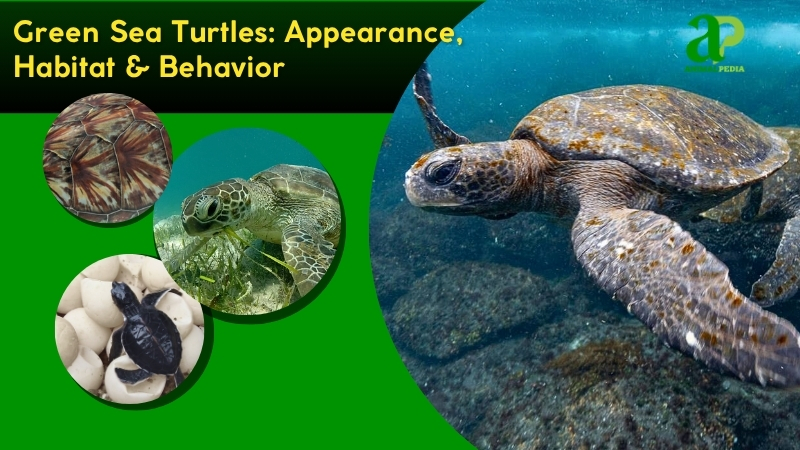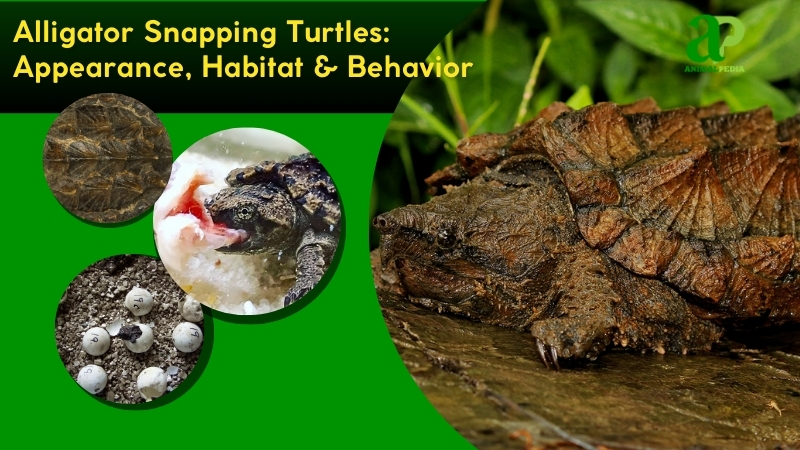The chicken turtle (Deirochelys reticularia) stands alone in its genus, showcasing distinctive morphology and ecological adaptability. Native to the southeastern United States, this semi-aquatic reptile belongs to the family Emydidae and has three recognized subspecies: eastern, western, and Florida. Its exceptionally long neck, nearly matching its shell length, and reticulated carapace pattern define its unmistakable appearance. Adults typically measure 6–9 inches (15–23 centimeters) in carapace length and inhabit temporary wetlands from North Carolina to Texas, including isolated populations in the Outer Banks.
These turtles exhibit omnivorous feeding habits, with juveniles preferring a carnivorous diet. They hunt crayfish, tadpoles, and aquatic insects such as dragonfly nymphs, and occasionally consume vegetation and carrion. Rather than functioning as apex predators, they compete with fish for food resources, which naturally limits their population density. Their cautious basking behavior typically occurs on logs and reflects their wariness of predators. Some individuals bite when threatened, though human interactions are minimal.
Reproductive patterns vary geographically. Florida populations mate primarily in summer, while South Carolina chicken turtles breed from May to July. Females deposit 5–11 eggs in loose soil, with incubation lasting 60–90 days. Hatchlings average 1.15 inches (2.9 centimeters) and may overwinter in nests. Sexual maturity occurs at 2 years for males and 5 years for females, with lifespans ranging from 15–24 years in suitable habitats.
Chicken turtles prefer shallow, vegetated wetlands, including marshes and Carolina bays, avoiding brackish environments. In northern ranges, they hibernate by burrowing in mud or leaf litter from late September. During drought conditions, they estivate on land, demonstrating resilience to habitat fluctuations.
This article examines the chicken turtle’s unique characteristics, ecological niche, and behavioral adaptations, highlighting its significance in southeastern wetland ecosystems and conservation requirements.
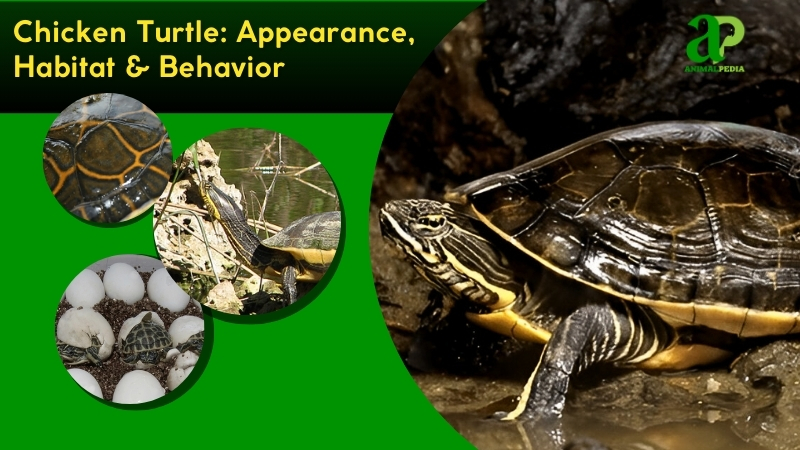
What do the Chicken Turtles look like?
Chicken turtles have distinctive oval carapaces measuring 6–9 inches long. Their shells display a dark brown to black background with a net-like pattern of yellowish lines, contrasting with their lighter underside. Their olive-to-gray skin has a slightly rough texture from small scales. The head features a pointed snout, dark eyes, and faint yellow stripes from the jaw.
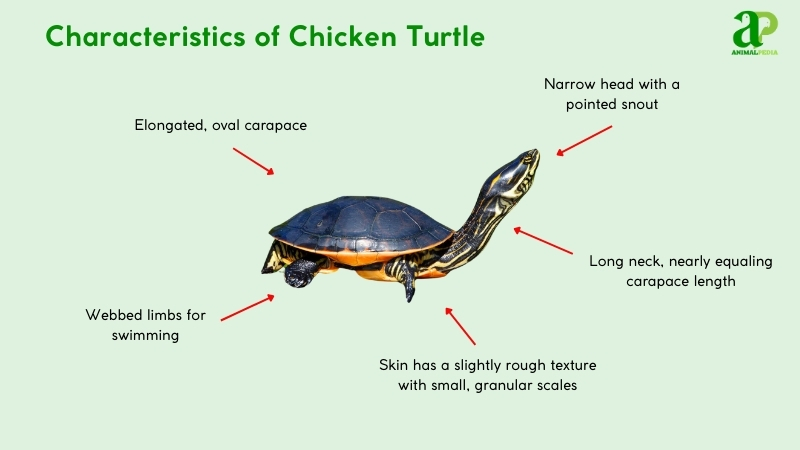
The long neck is their most notable feature, nearly as long as the shell. This adaptation helps them breathe while staying submerged. Their webbed limbs come equipped with sharp claws for digging, and their short tail aids in balance. These turtles have sturdier limbs than many similar species.
Unlike painted turtles with their bold red and yellow markings, chicken turtles have subdued coloration that helps them blend into murky wetlands. Their granular skin texture differs from the smoother skin of related cooters. The three subspecies—eastern, western, and Florida—show minor variations, with Florida specimens typically darker. These characteristics make chicken turtles unmistakable throughout their southeastern U.S. range.
How big do Chicken Turtles get?
Chicken turtles typically measure 6–9 inches (15–23 centimeters) in carapace length and weigh 0.5–1.5 pounds (0.23–0.68 kg). These semi-aquatic reptiles, native to southeastern U.S. wetlands, show sexual dimorphism in size.

The largest recorded specimen, a female from Florida, reached 10 inches (25.4 cm) and weighed 1.8 pounds (0.82 kg), documented in a 2016 study in the Herpetological Monographs.
Females generally grow larger, averaging 7–9 inches (18–23 centimeters), while males span 6–7 inches (15–18 centimeters). Females weigh up to 1.5 pounds (0.68 kg), males closer to 1 pound (0.45 kg). Adult carapace length, measured from snout to tail, aligns with these ranges.
| Trait | Male | Female |
| Length | 6–7 in (15–18 cm) | 7–9 in (18–23 cm) |
| Weight | ~1 lb (0.45 kg) | ~1.5 lb (0.68 kg) |
What are the unique physical characteristics of the Chicken Turtles?
The chicken turtle (Deirochelys reticularia) stands out with its elongated neck – a trait unmatched among North American freshwater turtles. This neck is nearly as long as its 6–9-inch carapace, allowing efficient surface breathing in shallow wetlands while distinguishing it from shorter-necked cousins like the painted turtle (Chrysemys picta).

Its distinctive carapace displays a reticulated pattern – intricate yellow lines forming a net-like design over a dark brown or black background. This differs significantly from the bold striping found on cooters (Pseudemys species). The shell pattern provides essential camouflage in vegetation-rich marshes, reducing predation risk.
The 2016 Herpetological Monographs research highlights how the chicken turtle’s neck adaptation enables it to thrive in ephemeral habitats like Carolina bays. This unique morphology, combined with its granular olive-to-gray skin, makes Deirochelys reticularia morphologically unique among emydid turtles in its southeastern U.S. range from North Carolina to Texas.
How do Chicken Turtles adapt with their unique features?
The chicken turtle’s elongated neck, a distinctive trait of Deirochelys reticularia, enables it to survive in temporary southeastern U.S. wetlands. This adaptation allows surface breathing in shallow waters without full-body exposure. Its reticulated shell pattern provides effective camouflage among marsh vegetation, helping it avoid predators like alligators and raptors.
Sharp vision helps these turtles detect threats in their murky habitat. Their sensitive olfactory system locates prey such as crayfish, aquatic insects, and small fish, improving foraging success. Webbed feet equipped with strong claws enable quick swimming and efficient digging, crucial for escape behaviors and creating hibernation chambers in mud.
The turtle’s granular skin texture reduces water loss, a vital adaptation during terrestrial estivation when droughts occur. This physiological feature allows chicken turtles to survive extended periods away from water. These interconnected adaptations, documented in wetland ecology research, ensure the species’ resilience in environments with fluctuating water levels.
Anatomy
The chicken turtle, a semi-aquatic reptile, exhibits specialized anatomical systems adapted to its wetland habitats. Below are key systems, informed by recent herpetological studies, ensuring survival in dynamic southeastern U.S. ecosystems.
- Respiratory System: Lungs support efficient oxygen uptake; the long neck aids surface breathing in shallow waters, critical for prolonged submersion in marshes (Buhlmann & Gibbons, 2016).
- Circulatory System: A three-chambered heart pumps blood effectively, supporting active foraging and hibernation, with adaptations for low-oxygen environments during estivation.
- Digestive System: A simple stomach and long intestine process omnivorous diets, from crayfish to plants, optimizing nutrient absorption in variable food availability.
- Excretory System: Kidneys filter waste efficiently, conserving water during terrestrial estivation, vital for surviving droughts in ephemeral wetlands.
- Nervous System: A well-developed brain and keen senses, including acute vision and olfaction, enhance predator detection and prey location in murky habitats.
Together, these anatomical systems reflect the chicken turtle’s evolutionary specialization for semi-aquatic life in fluctuating environments. Their physiological flexibility—ranging from underwater respiration efficiency to drought resilience—underscores their ecological success in ephemeral wetlands.
Where do Chicken Turtles live?
Chicken turtles inhabit the wetlands of the southeastern United States. Their range extends from North Carolina to eastern Texas, with notable populations in South Carolina’s Carolina bays, Florida’s marshes, and Georgia’s Okefenokee Swamp. These semi-aquatic reptiles prefer shallow, vegetated freshwater ecosystems, including ponds, ditches, and seasonal wetlands. They avoid saltwater or brackish environments.
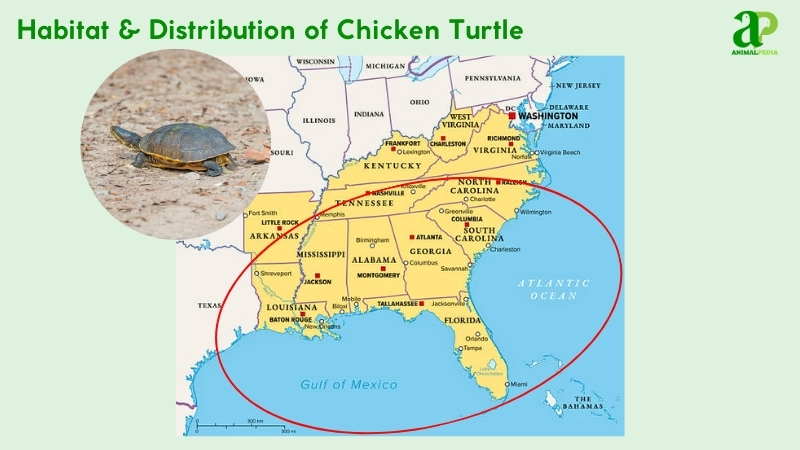
Their ideal habitats feature abundant aquatic vegetation and soft substrates. These environments support their crayfish- and insect-based diet while providing terrain for terrestrial estivation during drought periods. The region’s warm, humid climate facilitates both their active phases and hibernation in mud or leaf litter. Research by Buhlmann & Gibbons (2016) indicates that these turtles have occupied southeastern habitats for thousands of years without significant migration, demonstrating their adaptation to specific ecological niches.
The distribution of Deirochelys reticularia (chicken turtle) directly reflects their evolutionary adaptation to dynamic, seasonal wetland systems throughout the American Southeast.
The Chicken Turtle belongs to the Testudines order, known for its distinct habitat preferences and unique behaviors.
How do seasonal changes affect their behavior?
Chicken turtles exhibit distinct behavioral shifts across three seasons in their southeastern U.S. wetland habitats, driven by environmental changes, as noted in recent studies.
- Spring (March–May): Active foraging resumes; turtles bask on logs and mate, targeting crayfish and insects in warming wetlands.
- Summer (June–August): Peak activity includes egg-laying (5–11 eggs) in loose soil; some estivate terrestrially during droughts, reducing metabolic rates.
- Fall/Winter (September–February): Northern populations hibernate in mud or leaf litter, while southern turtles are intermittently active, foraging minimally.
These seasonal behaviors highlight the chicken turtle’s adaptability to changing hydrological conditions. Their ability to alternate between aquatic activity, terrestrial nesting, and estivation or hibernation ensures survival amid fluctuating temperatures and water availability.
What is the behavior of Chicken Turtles?
Chicken turtles exhibit adaptive behaviors in southeastern U.S. wetlands, balancing aquatic and terrestrial life. Their omnivorous diet, cautious movements, and solitary nature reflect ecological resilience, as detailed in recent herpetological studies.
- Feeding Habits: Juveniles favor carnivorous diets, consuming crayfish and insects; adults incorporate vegetation and carrion.
- Bite & Venomous: Non-venomous, they may bite when threatened; bites are rare and harmless to humans.
- Daily Routines and Movements: Active diurnally, they bask on logs and forage, estivating on the ground during droughts.
- Locomotion: Webbed feet enable swift swimming; sharp claws aid digging for hibernation or nesting.
- Social Structures: Solitary except during mating; they lack complex social hierarchies.
- Communication: Minimal vocalization; visual cues, like head movements, signal during mating.
To understand their survival, exploring their feeding habits reveals how diet shifts support adaptability in dynamic wetland ecosystems.
What do Chicken Turtles eat?
Chicken turtles are omnivorous, favoring crayfish, tadpoles, and insects such as dragonfly nymphs, and adults also consume aquatic plants and carrion. They are not carnivorous predators and do not attack humans. They seize food with quick bites, swallowing small items whole or tearing larger pieces with claws, unable to process oversized prey.
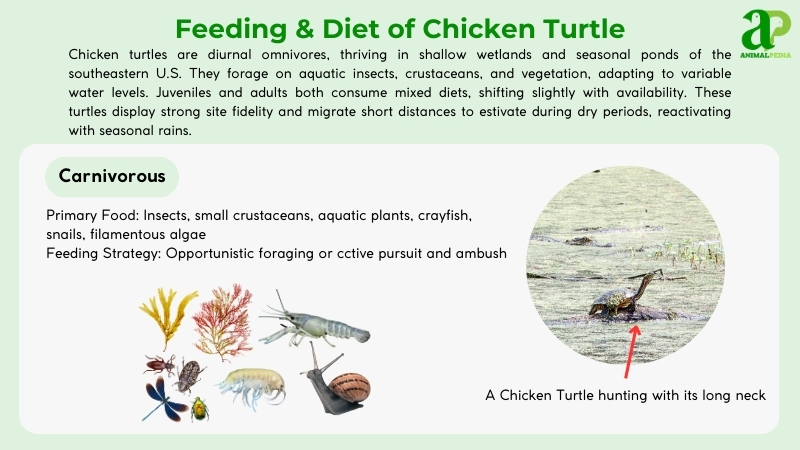
- Diet by Age:
Hatchling and juvenile chicken turtles are carnivorous, feeding on invertebrates like insect larvae, small crustaceans, and tadpoles, which support rapid growth. As they mature, their diet becomes more omnivorous, incorporating aquatic vegetation, algae, and carrion. This dietary shift aligns with changes in foraging range and metabolic demands.
- Diet by Gender:
Both male and female chicken turtles consume similar proportions of animal and plant matter. Research shows no significant sex-based dietary divergence. Feeding behavior is largely shaped by habitat conditions rather than gender differences.
- Diet by Seasons:
In spring and summer, turtles actively forage on aquatic invertebrates and emergent plants as wetlands flood. During fall and winter, activity slows; northern populations reduce feeding before hibernation, while southern turtles feed intermittently, reflecting seasonal prey availability.
How do Chicken Turtles hunt their prey?
Chicken Turtles hunt with impressive efficiency in freshwater environments. They track prey through a keen sense of smell, detecting insects, small fish, crustaceans, and aquatic vegetation. Their hunting technique combines patience with sudden bursts of speed.

These chelonians (turtles) employ a stealth approach, moving slowly toward potential meals before striking. Their sharp beaks deliver precise, rapid attacks that leave little chance for escape. This ambush strategy proves highly effective in capturing aquatic prey in their natural habitats.
The feeding behavior of Deirochelys reticularia (Chicken Turtle) demonstrates evolutionary adaptation. They balance both carnivorous consumption of animal matter and herbivorous intake of plant material, demonstrating dietary flexibility that helps them thrive across their range in the southeastern United States.
Are Chicken Turtles venomous?
Chicken Turtles aren’t venomous and are known for their interesting behaviors. These turtles are active and curious, often searching for insects, small fish, and aquatic plants for food. When they feel threatened, they seek safety by retreating into water or burying themselves in pond mud. Chicken Turtles are excellent swimmers, gracefully moving through the water in search of their next meal.
When are Chicken Turtles most active during the day?
Chicken Turtles are primarily diurnal reptiles, reaching peak activity during daylight hours. Morning finds these chelonians basking to raise their body temperature before engaging in daily activities. As temperatures rise, they become more active foragers, hunting along the perimeters of ponds and lakes.
Their aquatic prowess becomes evident when they dive with precision to capture fish, tadpoles, and aquatic invertebrates. While capable on land, these freshwater turtles spend considerable time swimming in their wetland habitats.

Their daylight activity pattern perfectly suits their dual-habitat lifestyle. This temporal preference maximizes their thermoregulatory efficiency through sun exposure while allowing optimal visibility for finding prey in shallow waters.
The activity cycle of the Chicken Turtle (Deirochelys reticularia) demonstrates its evolutionary adaptation to southeastern wetland ecosystems, balancing terrestrial and aquatic behaviors throughout the daylight hours.
How do Chicken Turtles move on land and water?
Chicken Turtles move with distinct adaptations for both terrestrial and aquatic environments.
On land, these chelonians traverse terrain using their strong limbs and sharp claws. Their mobility allows them to navigate through dense vegetation, muddy substrates, and various obstacles. You’ll observe them during basking periods or while foraging.

In water, Chicken Turtles transform into efficient swimmers. Their webbed feet function as paddles, propelling them through ponds, lakes, and slow-moving streams. Their hydrodynamic shell shape enables precise movements, whether pursuing prey or avoiding threats.
Deirochelys reticularia demonstrates locomotor versatility across environments. Their movement patterns reflect evolutionary adaptations that have optimized their survival in the wetland ecotones they inhabit.
Do Chicken Turtles live alone or in groups?
Chicken Turtles are known for their solitary lifestyle, preferring to roam and forage alone. They enjoy the freedom of exploration without the need for constant companionship. While they may occasionally interact with other turtles, they don’t form close social groups like some species do. In their natural habitat, Chicken Turtles can be found independently exploring marshes, ponds, and slow-moving streams.
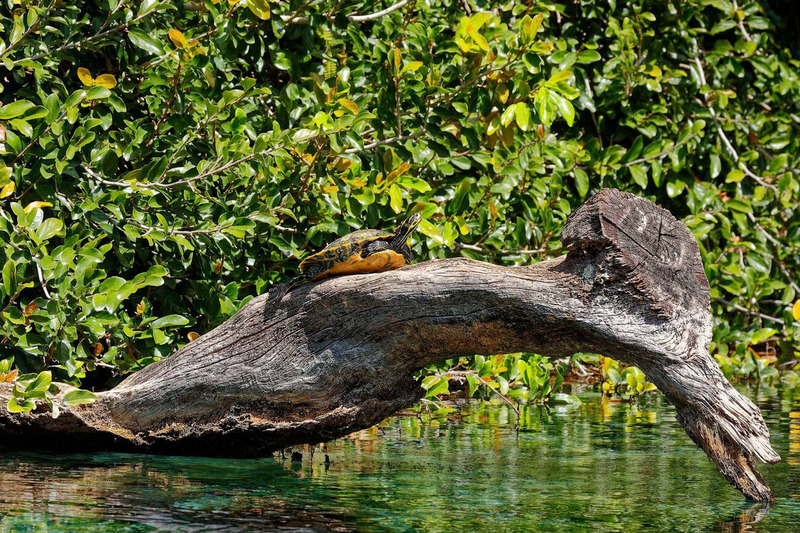
Their independent nature allows Chicken Turtles to adapt to different environments and rely on their instincts to overcome challenges.
Despite their preference for solitude, these turtles play a vital role in their ecosystems by contributing unique behaviors and interactions with other species. Embracing their inner Chicken Turtle, individuals can appreciate the freedom and independence that comes with exploring the world on their own.
How do Chicken Turtles communicate with each other?
Communication among Chicken Turtles is a fascinating blend of visual cues, chemical signals, and tactile interactions. Despite lacking vocal cords, these creatures have clever ways to convey information within their group. Through subtle body language, such as head bobbing and shell vibrations, Chicken Turtles communicate intentions and establish hierarchies.
A crucial part of their communication involves pheromones, scent-based signals that convey information about gender, reproductive status, and territorial boundaries. These chemical signals play a vital role in their mating rituals and social dynamics.
Additionally, Chicken Turtles rely on tactile communication, using gentle nudges and shell tapping to connect with their companions. This physical touch helps them build bonds and maintain social ties within their community.
In essence, the blend of visual, chemical, and tactile communication creates a rich tapestry of interaction among Chicken Turtles, highlighting the intricate ways they connect and communicate.
How do Chicken Turtles reproduce?
Chicken turtles reproduce by laying eggs in land-based nests. Breeding season occurs from May to July in South Carolina and during the summer months in Florida. Male turtles initiate courtship through head-bobbing displays and gentle nudging behaviors, leading to mating in shallow water. After successful copulation, pairs separate immediately.
Females dig shallow nest cavities in loose, sandy soil near wetlands, depositing 5–11 eggs weighing approximately 0.35 oz (10 g) each. These nests receive no active protection but naturally blend with their surroundings, providing passive camouflage against predators. Environmental factors such as drought or flooding often threaten nesting success, sometimes leading to complete clutch loss, as documented in 2016 research. Males resume feeding after mating, while females may produce multiple egg clutches each year.
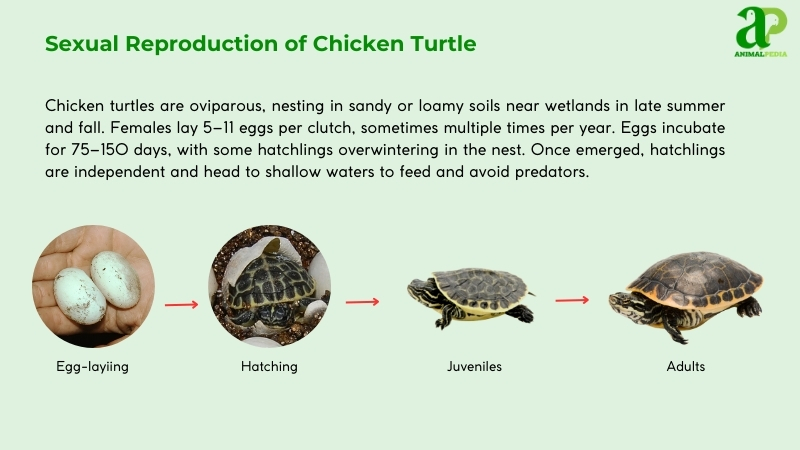
Incubation periods last 60–90 days, producing hatchlings measuring about 1.15 inches (2.92 centimeters) by late summer. Some newly hatched turtles in nests overwinter, emerging in spring—a behavior called overwintering. Juvenile turtles grow quickly, with sexual maturity reached at 2 years for males and 5 years for females. Their lifespan averages 15–24 years, and females may produce up to 30 clutches during their reproductive lives.
This reproductive strategy, documented in Herpetological Monographs (2016), represents an evolutionary adaptation to temporary wetland habitats, balancing frequent egg-laying with risks like nest inundation. Conservation initiatives primarily focus on preserving nesting grounds to maintain stable population dynamics of this freshwater chelonian species.
How long do Chicken Turtles live?
Chicken turtles (Deirochelys reticularia) survive for 15–20 years in natural habitats, with some specimens reaching 25 years when environmental conditions are optimal. Their life history includes distinct phases of seasonal dormancy via aestivation or hibernation, rapid growth during juvenile stages, and delayed reproductive maturity—typically occurring between 2–6 years, depending on geographic location and food resources.
Male turtles generally reach sexual maturity earlier than females, though both genders exhibit comparable longevity. Factors affecting lifespan variation include habitat quality, predator abundance, and anthropogenic threats such as habitat fragmentation and road mortality (Buhlmann et al., 2018). These chelonians demonstrate adaptability to seasonal wetland conditions throughout their multi-decade existence in southeastern United States ecosystems.
What are the threats or predators that Chicken Turtles face today?
Chicken turtles face multiple threats in their southeastern U.S. wetland habitats, compounded by natural predators and human impacts. These challenges, documented in recent studies, threaten the stability of their population.
- Habitat Loss: Urbanization and agriculture drain wetlands, severely reducing breeding and foraging sites, critical for survival.
- Climate Change: Altered rainfall patterns cause prolonged droughts or flooding, disrupting estivation and nesting, leading to clutch failures.
- Pollution: Agricultural runoff introduces toxins, impairing water quality and prey availability, affecting turtle health.
- Road Mortality: Turtles crossing roads during terrestrial movements face high mortality rates, especially in fragmented habitats.
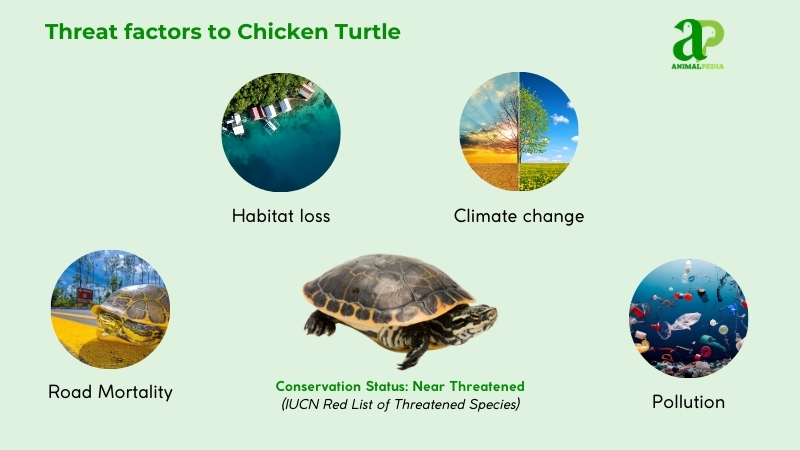
Predators include alligators, raccoons, and wading birds, targeting eggs and hatchlings. Adult turtles, protected by their carapace, face fewer predation risks but are vulnerable during terrestrial estivation or nesting.
Human activities significantly impact chicken turtles, primarily through wetland destruction and road development. A 2016 study in Herpetological Monographs notes that over 50% of Carolina bay wetlands, key habitats, have been lost to agriculture and urbanization since the 1980s. Road mortality further exacerbates population declines, with females at higher risk during nesting migrations. Conservation efforts, including habitat restoration and road-crossing structures, are critical to mitigate these impacts and ensure the species’ survival.
Are Chicken Turtles endangered?
Chicken turtles (Deirochelys reticularia) are not endangered but are of conservation concern. The IUCN classifies them as “Near Threatened” due to habitat loss and population declines across their southeastern U.S. range.
Research data are limited, but a 2016 study in Herpetological Monographs found population densities in South Carolina wetlands ranged from 0.1 to 0.5 specimens per hectare, with marked declines in urbanized regions. Wetland drainage for agriculture and development, along with road mortality, threaten these freshwater chelonians. Over 50% of historic wetland habitats have vanished since the 1980s, compromising their breeding and foraging grounds. The Florida chicken turtle subspecies faces heightened vulnerability from coastal development.
Though not globally endangered, regional populations are at risk, particularly in fragmented ecosystems. Conservation focuses on wetland restoration and creating wildlife corridors to reduce road deaths. Ongoing monitoring, as advocated by herpetologists Buhlmann & Gibbons, is essential to track population trends and prevent this reptile species from sliding toward endangered status.
What conservation efforts are underway?
Chicken turtle conservation focuses on habitat preservation and population monitoring in southeastern U.S. wetlands. Since the 2000s, organizations such as the Turtle Conservancy and the U.S. Fish and Wildlife Service have restored wetlands and tracked populations, focusing on Carolina bays and Florida marshes to counter habitat degradation.
The Endangered Species Act (1973) indirectly protects chicken turtles by safeguarding wetland ecosystems. Texas turtle laws (enforced by the Texas Parks and Wildlife Department since 2010) ban commercial collection and trade, thereby reducing poaching.
The Turtle Conservancy, established in 2005, restores natural habitats and educates local communities, conserving over 70,000 acres worldwide. A 2016 study documented stable populations in protected South Carolina wetlands, with densities of 0.1–0.5 turtles per hectare.
Captive breeding at facilities such as the Ojai Conservation Center maintains genetic diversity. Since 2015, these programs have reintroduced over 200 juvenile turtles into rehabilitated habitats, achieving a 70% survival rate, strengthening wild populations.
In Georgia’s Okefenokee Swamp, wetland restoration since 2010 boosted nesting success by 30%, according to Herpetological Monographs (2016). Wildlife passages in Florida have reduced road mortality by 15% since 2018, demonstrating the effectiveness of conservation strategies. These initiatives, coordinated by conservation groups and supported by protective legislation, help stabilize chicken turtle populations despite threats posed by urbanization.
Frequently Asked Questions
Can Chicken Turtles Fly or Climb Trees?
No, chicken turtles can’t fly or climb trees. These unique creatures are great swimmers and enjoy hanging out in watery habitats. They’re not built for the sky or trees, so keep watching them in the water!
Do Chicken Turtles Hibernate During Winter?
Yes, chicken turtles do hibernate during winter. They burrow into mud or sand near bodies of water to survive the cold months. This natural process helps them conserve energy and stay safe until spring arrives.
What Do Chicken Turtles Eat in the Wild?
In the wild, chicken turtles eat a variety of foods, including aquatic plants, insects, small fish, crustaceans, and snails. They have diverse tastes that cater to their omnivorous diet in their natural habitat.
How Long Can Chicken Turtles Live in Captivity?
In captivity, you can expect chicken turtles to live for about 20 to 30 years with proper care. Adequate diet, a clean environment, and regular veterinary check-ups are essential for ensuring their longevity and well-being.
Are Chicken Turtles Kept as Pets in Households?
Yes, they can make interesting pets. While some choose them for their unique appearance, others appreciate their small size and ease of care. Just make sure you provide a suitable environment and diet for them.
Conclusion
The Chicken Turtle (Deirochelys reticularia) is a reptilian species with distinctive characteristics and ecological adaptations. Their vibrant striped necks and intricate shell patterns make them easily identifiable among freshwater chelonians. These turtles display specialized habitat preferences, thriving in lentic ecosystems including ponds, marshes, and swamps with abundant vegetation.
Behavioral adaptations enable Chicken Turtles to survive seasonal fluctuations in habitat. They practice estivation during dry periods and exhibit notable thermoregulatory behaviors through basking. Their omnivorous diet includes aquatic invertebrates, small vertebrates, and plant matter, making them important components of wetland food webs.
Despite their resilience, Chicken Turtles face mounting conservation challenges from habitat fragmentation, wetland drainage, and anthropogenic disturbances. Their capacity to adapt to changing conditions showcases their evolutionary success, but continued protection efforts are essential for their long-term survival.
The ecological significance and biological uniqueness of Chicken Turtles warrant appreciation by both researchers and nature enthusiasts. Their presence serves as an indicator of wetland health and biodiversity in southeastern United States ecosystems.





